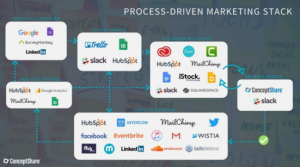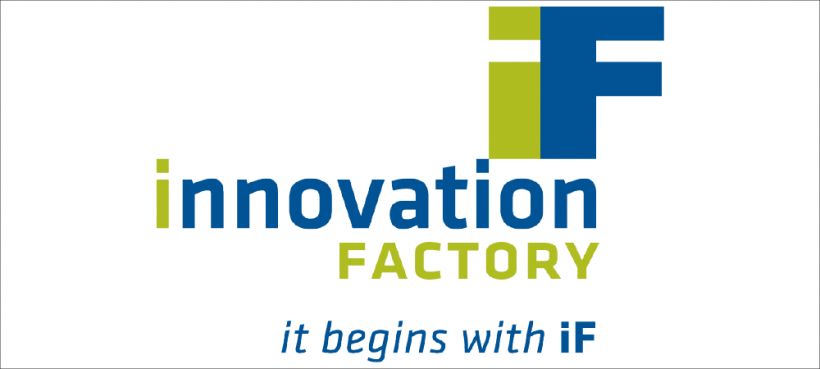With thousands of digital tools to support sales and marketing initiatives, choosing the right tools for your Startup or growing business can be a challenge. In a recent Innovation Factory Sales P2P I outlined my sales and marketing tech stack. In this blog post, I will give an overview of my presentation and discuss a few of my favorite tools.
Setting the Scene
With the continual evolution of the sales and marketing landscape, digital tools are required every step of the way. It is worth mentioning some important sales and marketing truisms when selecting the tools your business will use:
- Sales and Marketing is interconnected: This is especially true for Startups.This means there is no hand-off from marketing to sales when a lead is qualified, but a continual cross-over of both systems.
- It takes more and more work to make connections personal: With a growing list of automated tools, your prospects are getting solicited at exponential rates, limiting personal interactions.
- Buyers Self Educate: B2B buyers are making numerous decisions based solely on digital content, and many will have reached the buying decision without ever speaking to a sales rep.
- Process is Power: Startup sales and marketing teams need to establish clear processes based on quantifiable data and always commit to and trust the process.
- Digital tools must be organized: Just as my father knew the place for every tool in his workshop, the digital sales and marketing practitioner needs to be organized to be effective.
A Process Driven Sales and Marketing Stack

Every year at the MarTech conference, they present The Stackies, which are awarded to companies who can best showcase a single slide that illustrates the way they conceptualize their marketing stack. This year’s winners included Cisco, Microsoft, and a handful of other finalists. I found the process-driven marketing stack presented by Concept Share most closely aligned with what we have in place at VA Partners.
Using their process driver marketing stack as a starting point, I developed a sales and marketing stack presentation for an Innovation Factory Sales P2P presentation, outlining the following sections: research and discover, plan and collaborate, manage, create, engage, execute, and finally, analyze. A copy of my slide-deck can be found on SlideShare. I’ve listed some of my favorite tools for each process below.
Research and Discovery Tools:
If you are in the B2B space, LinkedIn is an essential tool for researching prospects and beginning to engage with them. While searches are limited with a free LinkedIn account, Sales Navigator can be worthwhile if you are prospecting daily. Don’t forget to join groups, post and share content, and keep your own profile up to date. A second, very simple tool I use daily is hunter.io. This tool works as a Google Chrome extension and will provide any email addresses connected to a company URL, suggesting standard name formulations attributed to the account. This can help you quickly deduce your prospect’s email address.
Plan and Collaborate:
Since we’re in different locations, our team at VA Partners finds Slack quite handy for quick communication. There are thousands of Slackbots that help create further efficiencies. We use Obie as a tool to help search our Dropbox database for info. Obie can also be used as a learning tool, with playbooks created to help new hires get up to speed faster.
Management Tools:
While I’ve used many different CRMs, I’ve found Hubspot to be light, agile, and simple enough to be able to train clients in about fifteen minutes (read my earlier blogpost on Hubspot for more details). Streak is another lightweight CRM that functions as a Gmail plugin. I really appreciated the bulk mailing functionality. Remember: your CRM is only as good as the information you provide it. You need to be diligent in keeping all your leads and opportunities recorded otherwise you’re simply wasting your time.
Create:
Its important to have marketing collateral that will support the sale. This can be a brochure, slide-deck, white paper, or infographic. There are a range of tools out there to develop them. Be sure to choose one based on your digital design skill level. On the professional side, Adobe has a suite of apps to support everything from photo enhancement to web development. If those apps are too complex, simpler tools include Google Slides, which has great template for creating decks, or Canva, an intuitive designer for creating infographics, brochures and one-pagers.
Engage:
While I’ve been using MailChimp and Hootsuite for a few years, a couple tools I’ve implemented recently are Mailshake and Go Video. Mailshake is an automated mailing system that helps you create email campaigns and will continue to reach out to a list of contacts until they’ve either responded or clicked on a link. At that point, the lead is removed from the automated system so you can follow up with them personally. Go Video by Vidyard helps you to create, share and track embedded videos in your email and works as a Google Chrome plugin.
Execute:
While it might not come to mind as part of your tech stack, I made sure to include a telephone graphic on my presentation slide deck and reminded everyone that this can still be one of your best tools to execute and sign new business. While it’s true that people may be hard to find, and might not pick up your call right away, you’ll want to be looking at the sales triggers to determine who the best candidates to reach out to are. I’ve found the best time to call is between 8 am – 9 am when my prospects are most likely at their desks.
Analyze:
You spend a lot of time and money developing your sales and marketing processes. Be sure you’re not just relying on anecdotal evidence, but use some good analytics tools to understand what processes are getting the best results for you. You can check out Kayla Thomson’s recent ‘beginners guide to Moz’ blog post to understand how that tool works to analyze and optimize your SEO strategy. While it’s much more than an analytics tool, the Aiva builder is an AI powered conversion rate optimization tool I’ve talked about before which increases conversion and helps you better understand your customers.
Bringing it all Together
There are thousands of sales and marketing tools out there. Quite of few of them are for “bringing it all together”! I’ve used apps like Zapier or IFTTT (If this then that). IFTTT calls these recipes, such as “If you get a new subscription sign up… then add them to the MailChimp list. A tool like this can be the glue that holds your marketing steps together. You can even create personal recipes for yourself like, “If there’s rain in the forecast… then email me a reminder to bring my umbrella.”
Be sure to also remember one last recipe for sales success: If you are a Startup or growing company looking for help in B2B Sales and Marketing… then be sure to connect with us at VA Partners!

